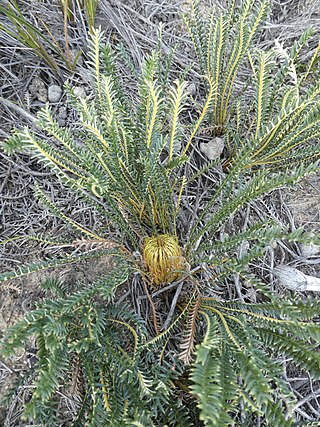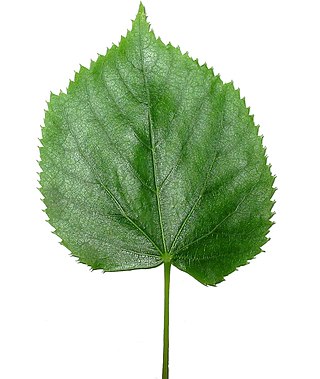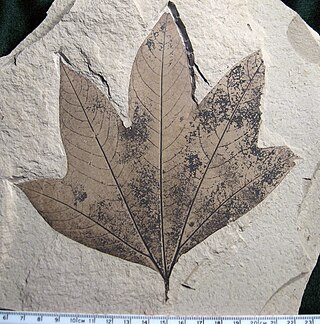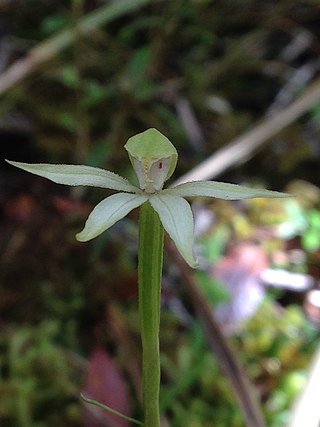
Pinnation is the arrangement of feather-like or multi-divided features arising from both sides of a common axis. Pinnation occurs in biological morphology, in crystals, such as some forms of ice or metal crystals, and in patterns of erosion or stream beds.

The Atherospermataceae, commonly known as the southern sassafrases, are a family of broadleaf evergreen trees and shrubs. The family includes 14 species in seven genera. The atherosperms are today mostly distributed in the Southern Hemisphere, with two species native to southern Chile and 12 species native to Australasia. Wood is commercially harvested from rainforest species of this family, and is used both in construction and in fine cabinet making.

Bennettitales is an extinct order of seed plants that first appeared in the Permian period and became extinct in most areas toward the end of the Cretaceous. Bennettitales were amongst the most common seed plants of the Mesozoic, and had morphologies including shrub and cycad-like forms. The foliage of bennettitaleans is superficially nearly indistinguishable from that of cycads, but they are distinguished from cycads by their more complex flower-like reproductive organs, at least some of which were likely pollinated by insects.

As with other flowering plants, the taxonomy of Banksia has traditionally been based on anatomical and morphological properties of the Banksia flower, fruiting structure and seed, along with secondary characteristics such as leaf structure and growth habit. Increasingly, molecular evidence from DNA is providing important new insights into relationships within the genus and between this and other genera in the Proteaceae.

The Proteaceae form a family of flowering plants predominantly distributed in the Southern Hemisphere. The family comprises 83 genera with about 1,660 known species. Australia and South Africa have the greatest concentrations of diversity. Together with the Platanaceae, Nelumbonaceae and in the recent APG IV system the Sabiaceae, they make up the order Proteales. Well-known Proteaceae genera include Protea, Banksia, Embothrium, Grevillea, Hakea, and Macadamia. Species such as the New South Wales waratah, king protea, and various species of Banksia, Grevillea, and Leucadendron are popular cut flowers. The nuts of Macadamia integrifolia are widely grown commercially and consumed, as are those of Gevuina avellana on a smaller scale.
Banksia strahanensis is an extinct species of tree or shrub in the plant genus Banksia. It is known only from a fossil leaf and several fossil leaf fragments found in Early to Middle Pleistocene sediment at Regatta Point in western Tasmania. These are long and very narrow, with entire margins, superficially resembling leaves of the extant B. spinulosa.
Banksieaephyllum is a plant genus that encompasses organically preserved fossil leaves that can be attributed to the Proteaceae tribe Banksieae, but cannot be attributed to a genus.

Banksia arctotidis is a species of prostrate shrub that is endemic to the southwest of Western Australia. It has leaves that are pinnately divided to the midrib, cream-coloured flowers and hairy, egg-shaped fruit.

Laurelia novae-zelandiae, also called pukatea, is a large evergreen tree, endemic to the forests of New Zealand. Pukatea has 'toothed' leaves and produces small flowers. It is a species in the Atherospermataceae family, typical representative of laurel forest ecoregion.

Donatia novae-zelandiae is a species of mat-forming cushion plant, found only in New Zealand and Tasmania. Common names can include New Zealand Cushion or Snow Cushion, however Snow Cushion also refers to Iberis sempervirens. Donatia novae-zelandiae forms dense spirals of thick, leathery leaves, creating a hardy plant that typically exists in alpine and subalpine bioclimatic zones.

A leaf is a principal appendage of the stem of a vascular plant, usually borne laterally above ground and specialized for photosynthesis. Leaves are collectively called foliage, as in "autumn foliage", while the leaves, stem, flower, and fruit collectively form the shoot system. In most leaves, the primary photosynthetic tissue is the palisade mesophyll and is located on the upper side of the blade or lamina of the leaf, but in some species, including the mature foliage of Eucalyptus, palisade mesophyll is present on both sides and the leaves are said to be isobilateral. The leaf is an integral part of the stem system, and most leaves are flattened and have distinct upper (adaxial) and lower (abaxial) surfaces that differ in color, hairiness, the number of stomata, the amount and structure of epicuticular wax, and other features. Leaves are mostly green in color due to the presence of a compound called chlorophyll which is essential for photosynthesis as it absorbs light energy from the Sun. A leaf with lighter-colored or white patches or edges is called a variegated leaf.
Banksieaeformis is a genus that encompasses plant species only known from fossil leaves that can be attributed to the Proteaceae tribe Banksieae, but cannot be attributed to an extant (living) genus. Unlike those classified in the related genus Banksieaephyllum, the leaves do not have their cuticular architecture preserved. The genus was defined by botanists Bob Hill and David Christophel in 1988 to distinguish banksia-like leaves that had been organically preserved from those that had not.

Caltha novae-zelandiae, commonly known as New Zealand marsh marigold or yellow caltha, is a small, perennial herbaceous plant belonging to the family Ranunculaceae, that grows in open vegetations in mountainous areas, and is endemic to New Zealand.
Araucaria haastii is an extinct species of conifer tree formerly native to New Zealand. A large number of fossilised tree specimens from the family Araucariaceae have been found in New Zealand, but in many cases the level of preservation is not sufficient to reliably distinguish between Araucaria species and Agathis species.

Macginitiea is an extinct genus in the family Platanaceae ranging from the Late Paleocene to Late Eocene of North America, known from the Clarno Formation of central Oregon and other areas ranging from California to Texas and North to Alberta. The genus is strictly used to describe leaves, but has been found in close association with other fossil platanoid organs, which collectively have been used for whole plant reconstructions. Macginitiea and its associated organs are important as together they comprise one of the most well-documented and ubiquitous fossil plants, particularly in the Paleogene of North America.
Acer taggarti is an extinct maple species in the family Sapindaceae described from a number of fossil leaves and samaras. The species is known from Miocene sediments exposed in central Oregon, US. It is one of several extinct species belonging to the living section Rubra.

Adenochilus gracilis is a species of plant in the orchid family Orchidaceae and is endemic to New Zealand. It has a long, thin underground rhizome, a single leaf on the flowering stem and a single white flower with glandular hairs on the outside. Its labellum has red to maroon bars and a central band of yellow calli, but is almost obscured by the dorsal sepal.

Comptonia columbiana is an extinct species of sweet fern in the flowering plant family Myricaceae. The species is known from fossil leaves found in the early Eocene deposits of central to southern British Columbia, Canada, plus northern Washington state, United States, and, tentatively, the late Eocene of Southern Idaho and Earliest Oligocene of Oregon, United States.
Banksia paleocrypta is an extinct species of Banksia in the family Proteaceae. The species is known from silcretes deposits from the Walebing and Kojonup regions of southwestern Australia dating to the Late Eocene. This species is the oldest fossil in the genus Banksia with evidence of stomata and trichomes, characteristics of xerophytes which are adapted to survive in environments with very little water. These traits slow water loss in arid climates. However Banksia paleocrypta is of special interest because it is dated 25 million years prior to the widely accepted timing for the onset of aridity that expanded globally during the Neogene.

Plantago novae-zelandiae is a species of flowering plant in the family Plantaginaceae that is endemic to New Zealand. Lucy Moore described P. novae-zelandiae in 1961. Plants of this species of plantain are perennial with a rosette habit, leaves widest above the middle, up to 4 ellipsoid seeds per capsule, glabrous bracts and sepals, and punctate leaves. It is listed as Not Threatened.













